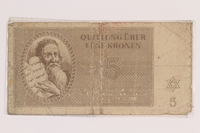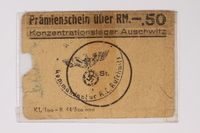Overview
- Brief Narrative
- Scrip received by Chaim Hollander when he was imprisoned in Sachsenhausen concentration camp. Scrip was issued in the camps as a means of improving worker productivity. Chaim and his brother, Fajwal, worked in the camp printing counterfeit British money as part of Operation Bernhard. After Germany invaded Poland in September 1939, Chaim and his family went into hiding. In August 1942, they were deported from Sosnowiec to the Srodula ghetto. After his wife and two young daughters were deported, Chaim escaped the ghetto and lived under a false identity until he was betrayed and deported to Auschwitz-Birkenau in December 1943. He found Fajwal there and they were transferred together to Sachsenhausen. Later they were deported to Mauthausen and then Ebensee, where they were liberated by the US Army on May 6, 1945. Chaim relocated to Belgium, where he had relatives. He heard from a neighbor that his wife was seen in Auschwitz, but was killed there.
- Date
-
received:
1944 January-1945 January
- Geography
-
issue:
Sachsenhausen (Concentration camp);
Oranienburg (Germany)
- Credit Line
- United States Holocaust Memorial Museum Collection, Gift of Lydia Hollander
- Contributor
-
Subject:
Chaim Hollander
- Biography
-
Chaim Hollander was born on April 20, 1906, in Dabrowa Tarnowska, Poland, to an Orthodox Jewish family. He had three brothers, Fajwal, Paul, and Adolf and four sisters. Chaim settled in Sosnowiec and owned a prosperous wholesale textile business. He married Frita (?) and they had two daughters, Rushkal (?), born 1933, and Lushka (?), born 1938.
Germany invaded Poland in September 1, 1939, and Chaim’s business was confiscated because he was Jewish. As persecutions of Jews increased, the family went into hiding in a pastor’s home. The pastor acquired false papers for the family and Chaim assumed the false identity, Edward Krakovski. Chaim left the family’s real papers and jewelry with the pastor. In August 1942, the family was deported to the Srodula ghetto. As deportations of Jews increased, the family hid in a one-room bunker in a basement with three families. While Chaim was out of the ghetto to obtain food, everyone in the bunker was deported. Chaim escaped in the middle of the night. The ghetto was heavily guarded and it took him four hours to go three blocks. He traveled to Bytom and was sheltered by the Poshomonka (?) family, who were customers before the war. He thought more Jews could hide in the house and contacted Vladek Chripfisch who was active in the Polish underground and claimed to have contacts in Auschwitz.
On December 13, 1943, Chaim went to a house in Sosnowiec where Vladek told him to leave money for two Jews to escape from Auschwitz. Two Germans entered the house and arrested Chaim. He tried to use his false identity, but they had a letter from Chaim to Vladek, revealing his true identity. He was taken to an office and interrogated. The man threatened to pull off his finger nails with tweezers if he did not tell the truth. Chaim was then locked in a basement and was told the interrogation would continue the next day. In the morning, a German asked if there were any Jews and Chaim said yes to avoid the interrogation. He was transported to a prison, where there were no other Jewish prisoners. Chaim said that he was a smuggler and did not tell anyone he was Jewish. He thought Vladek could get him out of jail and asked a prisoner who was about to be released to talk to Vladek in exchange for money. He revealed that he was Jewish, and the prisoner turned him in. He was taken to an office and beaten. He did not have a Star of David badge and was ordered to make one out of paper.
In late December 1943, Chaim was deported to Auschwitz-Birkenau concentration camp. He planned, with five other men, to jump out of the window, but the other passengers persuaded them to stay in the car. Upon arrival, Chaim was assigned to Birkenau. The prisoners were stripped for the showers and told to leave their money, but Chaim hid his money under his tongue. The barber inspected prisoners’ mouths for money, but he did not check Chaim’s because he told him that he had just been in prison. While he was waiting to be assigned a barrack, a prisoner gave him food because he was a friend of Chaim’s brother, Paul, who was a member of a Communist group. He slept in a horse stall with no heat. He found his brother, Fajwal, who had been deported to the camp a few months earlier. While imprisoned at the camp, Chaim and Fajwal went by the German names, Henryk and Felix. Fajwal convinced the manager of the kitchen to give Chaim a job mashing potatoes, in exchange for Chaim’s money. One day, Chaim told a prisoner to take a meal to his sick friend. German guards saw the steam when the prisoner opened the container. A Kapo was ordered to beat the four prisoners who worked in the kitchen fifty times. The Kapo had been Chaim’s customer before the war. He told Chaim to scream but did not beat him. The next day, the other three workers in the kitchen were killed.
In January 1944, Fajwal was selected to be killed. Chaim heard that the Germans were looking for skilled workers and went to the office. There was a long line of prisoners waiting to enter, but Chaim gave the guards cigarettes and was allowed in with Fajwal. There was another long line inside and Chaim pushed Fajwal to the front. A German officer, Bernhard Kruger, noticed this and selected Chaim because he looked healthy. Chaim said that he was a carpenter, as well as his brother, because he did not know what skills Kruger was seeking. The borthers then were transferred to Sachsenhausen. They were put to work making counterfeit money and forged documents. They were isolated from the rest of the camp and were not allowed to leave their block. Their work was part of a secret German project, Operation Bernhard, designed to weaken the British economy by overwhelming the market with counterfeit pound notes. In January 1945, Fajwal and Chaim were transferred to Mauthausen concentration camp, and then to the sub-camp, Ebensee.
The United States Army liberated Ebensee on May 6, 1945. Chaim briefly lived in Czechoslovakia before returning to Sosnowiec. The pastor who hid Chaim’s family returned the possessions that had been left with him during the war. Chaim learned that he had lost eighteen family members during the war. His father had been killed in a Jewish cemetery and his mother and sisters were shot after jumping from a train en route to a concentration camp. He heard from a neighbor that his wife was seen in Auschwitz; it is assumed that his wife and children were killed there. Chaim also learned that Vladek had turned him into the Germans. He received a telegram from his brother Paul that he and Adolf were alive; Adolf had married a Catholic woman and lived in Belgium; Paul had joined the Belgian underground movement. Chaim moved to Antwerp where he met Kajla-Rykwa Miller, who had returned to Belgium from the United States to find surviving family members. She was born in Skierniewice, Poland, but grew up in Belgium. She emigrated to the United States with her sister, Suzi, in 1940. Her parents and cousin, Esther, perished in the Holocaust. Chaim and Kajla-Rykwa married and moved to the United States in 1948. The couple had two children. Chaim passed away, age 84, on July 18, 1990.
Physical Details
- Language
- German
- Classification
-
Exchange Media
- Category
-
Money
- Object Type
-
Scrip (aat)
- Physical Description
- Small squarish scrip on rectangular white cardboard that has been laminated. In the center is a preprinted outline of a rectangle in black ink; within is German text and the denomination 10. Each top corner has a circular, purple stamp with a double outline, acronyms, and numbers. A small layer of cardboard is missing in the center. On the reverse is handwritten German text.
- Dimensions
- overall: Height: 1.500 inches (3.81 cm) | Width: 2.120 inches (5.385 cm)
- Materials
- overall : paper, ink, plastic laminate
- Inscription
- front, top left corner, stamped within circle in purple ink : BL. / 19 / AL
front, top right corner, stamped within circle in purple ink : 19 / AL
front, center, printed in black ink : Wert / 10 [Worth / 10]
reverse, cursive, black ink : K.L. / Sachsenhausen / Oranienburg
Rights & Restrictions
- Conditions on Access
- No restrictions on access
- Conditions on Use
- No restrictions on use
Keywords & Subjects
Administrative Notes
- Legal Status
- Permanent Collection
- Provenance
- The Sachsenhausen scrip was donated to the United States Holocaust Memorial Museum in 2010 by Lydia Hollander, the daughter of Chaim Hollander.
- Funding Note
- The cataloging of this artifact has been supported by a grant from the Conference on Jewish Material Claims Against Germany.
- Record last modified:
- 2023-10-16 13:43:13
- This page:
- https://collections.ushmm.org/search/catalog/irn41677
Download & Licensing
In-Person Research
- By Appointment
- Request 21 Days in Advance of Visit
- Plan a Research Visit
- Request to See This Object
Contact Us
Also in Chaim and Regina Hollander collection
The collection consists of artifacts, documents, an oral history audiocassette, and photographs relating to the experiences of Chaim Hollander in Poland during and after the Holocaust, and of Kajla-Rykwa Miller in Belgium during the Holocaust.
Date: 1940 March 02-1947

Theresienstadt ghetto-labor camp scrip, 5 kronen note
Object
Scrip, valued at 5 kronen, issued in the Theresienstadt (Terezin) ghetto-labor camp in 1943 and owned by Chaim Hollander. All currency was confiscated from deportees upon entry and replaced with scrip and coupons that could be exchanged only in the camp. After Germany invaded Poland in September 1939, Chaim and his family went into hiding. In August 1942, they were deported from Sosnowiec to the Srodula ghetto. After his wife and two young daughters were deported, Chaim escaped the ghetto and lived under a false identity until he was betrayed and deported to Auschwitz-Birkenau in December 1943. He found Fajwal there and they were transferred together to Sachsenhausen. Later they were deported to Mauthausen and then Ebensee, where they were liberated by the US Army on May 6, 1945. Chaim relocated to Belgium, where he had relatives. He heard from a neighbor that his wife was seen in Auschwitz, but was killed there.

Auschwitz concentration camp scrip type 3, .50 Reichsmark, received by a Polish Jewish inmate
Object
Type 3 Auschwitz scrip, valued at .50 Reichsmark, received by Chaim Hollander when he was imprisoned in Auschwitz-Birkenau. Scrip was issued in the camps as a means of improving worker productivity. After Germany invaded Poland in September 1939, Chaim and his family went into hiding. In August 1942, they were deported from Sosnowiec to the Srodula ghetto. After his wife and two young daughters were deported, Chaim escaped the ghetto and lived under a false identity until he was betrayed and deported to Auschwitz-Birkenau in December 1943. He found Fajwal there and they were transferred together to Sachsenhausen. Later they were deported to Mauthausen and then Ebensee, where they were liberated by the US Army on May 6, 1945. Chaim relocated to Belgium, where he had relatives. He heard from a neighbor that his wife was seen in Auschwitz, but was killed there.
Chaim and Regina Hollander papers
Document
Collection of materials documenting the experiences of Chaim (Henryk) Hollander and Kajla-Rywka Miller (later Regina Hollander) [donor's parents] during the time period surrounding the Holocaust. Collection includes identity papers, scrip, correspondence, passports, a photo of a drawing, and an audio cassette oral history interview with Chaim Hollander
Oral history interview with Chaim Hollander
Oral History



